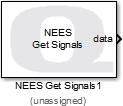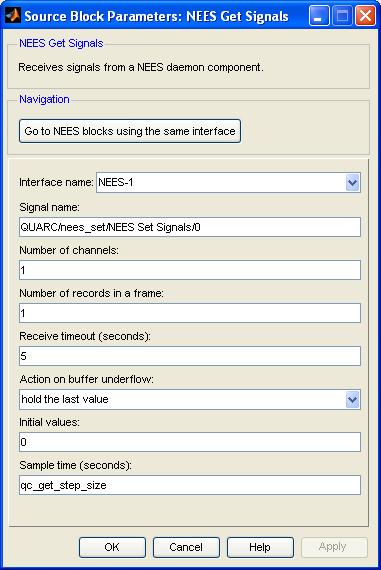

NEES Get Signals
| The NEES Get Signals block has been deprecated and should not be used in new models. |
This block receives data from a NEES daemon.
Library
QUARC Targets Deprecated/Communications/NEES MATLAB Command Line Click to copy the following command line to the clipboard. Then paste it in the MATLAB Command Window: qc_open_library('quarc_library_deprecated/Communications/NEES')
Description

This block receives data streamed from an RBNB repository via the Quanser NEES Daemon. The name of the data to retrieve from the repository is specified in the Signal name parameter. The full hierarchical path of the signal must be specified, prefixed by the name of the RBNB application name. Separate levels in the hierarchy with a forward slash. For example, 'Quanser/mymodel/mysubsystem/NEES Set Signals/0' indicates first element of the data sent to the Quanser NEES Daemon application named 'Quanser' and generated using a NEES Set Signals block in subsystem 'mysubsystem' of model 'mymodel'. For efficiency, the data is streamed from the Java daemon in frames. Each frame consists of a number of records, where each record contains the value(s) of the data at a single time instant.
For example, suppose data was written to the repository as a 3-vector using a NEES Set Signals block. The individual signals would appear in the repository as:
Entering a signal name of 'Quanser/mymodel/mysubsystem/NEES Set Signals' would cause all three signals to be streamed to the NEES Get Signals block. In this case, the Number of channels parameter must be set to 3. Thus, in this example, a record contains three elements. If the data in the repository was sampled at one kiloHertz and the number of records in a frame is set to 100, then the NEES Get Signals block will receive 100 records (300 elements) from the RBNB repository at a time. Transmitting the data in frames works well if the data already exists in the repository. However, if the data is been written to the repository at the same time as it is being read then it is better to use a frame size of 1 so that the most recent data is retrieved as soon as it is available, rather than waiting for a larger frame to become available.
Installation Requirements
Java Version
 The Quanser NEES Daemon requires that Java 8 (also known as 1.8) or above be installed.
A suitable Java Runtime Environment may be found online at https://www.oracle.com/java/technologies/downloads/.
Refer to the Quanser NEES Daemon help page for more details.
The Quanser NEES Daemon requires that Java 8 (also known as 1.8) or above be installed.
A suitable Java Runtime Environment may be found online at https://www.oracle.com/java/technologies/downloads/.
Refer to the Quanser NEES Daemon help page for more details.
Input Ports
This block has no input ports.
Output Ports
data
The data received from the Quanser NEES daemon. This data can be in n-vector format which means receiving n signals at the same time from the same daemon.
Parameters and Dialog Box

Go to NEES blocks using the same interface
Opens a dialog that lists all the NEES blocks in the model which are currently using the same interface selected in the Interface name parameter. The dialog may be used to go to another NEES block in the model just by double-clicking on the name of the block in the dialog box.
Interface name
The name of the interface containing the component whose value will be retrieved. Interfaces are configured using the NEES Initialize block. Place a NEES Initialize block in your diagram to add an interface name to the list.
Signal name
The full hierarchical name of the signal in the RBNB repository. Separate levels in the hierarchy by a forward slash, '/'.
Number of channels
The number of channels in a record. The number of channels determines the width of the output port. This parameter must match the number of channels in the signal specified by the Signal name parameter.
Number of records in a frame
The number of records (sampling instants) in a frame. This parameter defines how often the Quanser NEES Daemon will send data to the NEES Get Signals block from the RBNB repository.
Receive timeout
The amount of time in seconds that the block will wait to receive data in a given sampling instant. Specify a value of 0 for no timeout. A non-zero timeout prevents the real-time code from being delayed by the non-real-time operation of the repository.
Action on buffer underflow
If there is no more data in the repository for the selected signal or data from the repository does not arrive in time, then there are two options: either hold the last value at the output or reset the output to the value specified in the Initial values parameter. This parameter allows one of these two options to be selected.
Initial values
The initial value(s) to present at the output of the block at model start. The value of this parameters also used if the reset
option is selected for the Action on buffer underflow parameter.
Sample time
The sample time of the block. A sample time of 0 indicates that the block will be treated as a continuous time block. A positive sample time indicates that the block is a discrete time block with the given sample time.
A sample time of -1 indicates that the block inherits its sample time. Since this is a source block, only inherent the sample time when it is placed in a conditionally executed subsystem, like a Triggered or Enabled Subsystem, or in a referenced model.
To use the fundamental sampling time of the model, set the sample time to qc_get_step_size, which is a QUARC function that returns the fundamental sampling time of the model.
Targets
|
Target Name |
Compatible* |
Model Referencing |
Comments |
|---|---|---|---|
|
Yes |
Yes |
Only supported in normal simulation. |
|
|
Yes |
Yes |
Only supported in normal simulation. |
|
|
Yes |
Yes |
||
|
Yes |
Yes |
||
|
Yes |
Yes |
||
|
Yes |
Yes |
||
|
Yes |
Yes |
||
|
Yes |
Yes |
||
|
Yes |
Yes |
||
|
Yes |
Yes |
||
|
No |
No |
Not supported. |
|
|
Yes |
Yes |
||
|
No |
No |
Not supported. |
|
|
No |
No |
Not supported. |
|
|
Rapid Simulation (RSIM) Target |
No |
No |
Not supported. |
|
S-Function Target |
No |
N/A |
Old technology. Use model referencing instead. |
|
Normal simulation |
Yes |
Yes |
Fully supported. Use System Timebase block in Normal simulation. |
See Also

Copyright ©2025 Quanser Inc. This page was generated 2025-11-01. Submit feedback to Quanser about this page.
Link to this page.